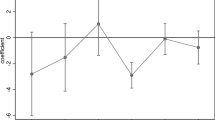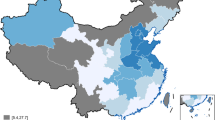Abstract
To deal with severe air pollution arising from rapid development, a series of air pollution control policies have been implemented in China. Previous literature has explored the short-term economic impacts of air pollution control, but the long-term economic impacts, which can better reflect the effectiveness of air pollution control, have received less attention. This paper has constructed an integrated assessment framework combining a multi-sectoral computable general equilibrium (CGE) model, air quality estimation module, and health impact module, to explore the short-term (2016) and long-term (2030) impacts of air pollution control on China’s economy, by setting 2015 as the base year. The possible future air pollution reduction scenarios were set based on the Thirteenth Five-Year Plan (FYP13) proposed by the Chinese government. Our results have shown that air pollution control would harm China’s economy and such adverse effects would be increased by stricter pollution reduction targets. Taking the health benefits of air pollution control into account can effectively alleviate the GDP losses, and even reverse them into economic benefits in the long term. Compared with business-as-usual (BAU) scenario (no policy constraints on SO2 and NOx emissions), the impact of air pollution control on GDP in the TAC_VIII scenario (emission reduction targets of 20% for SO2 and NOx are set every five years after 2015) would change from a loss of 1.20% in 2016 to an increase of 0.28% in 2030. Our results can provide policy implications for the optimization of China’s air emissions control in the future.







Similar content being viewed by others
Data availability
The data that support the findings of this study are available upon reasonable request from the authors.
References
Albrizio S, Koźluk T, Zipperer V (2017) Environmental policies and productivity growth: evidence across industries and firms. J Environ Econ Manag 81:209–226
Allan G, Lecca P, McGregor P, Swales K (2014) The economic and environmental impact of a carbon tax for Scotland: a computable general equilibrium analysis. Ecol Econ 100:40–50
Alton T, Arndt C, Davies R, Hartley F, Makrelov K, Thurlow J, Ubogu D (2014) Introducing carbon taxes in South Africa. Appl Energ 116:344–354
Berman E, Bui L (2001) Environmental regulation and labor demand: evidence from the South Coast Air Basin. J Public Econ 79:265–295
Büke T, Köne AÇ (2011) Estimation of the health benefits of controlling air pollution from the Yatağan coal-fired power plant. Environ Sci Policy 14(8):1113–1120
Chan C, Yao X (2008) Air pollution in mega cities in China—a review. Atmos Environ 42:1–42
Chen R, Kan H, Chen B, Huang W, Bai Z, Song G, Pan G, Group CC (2012) Association of particulate air pollution with daily mortality: The China Air Pollution and Health Effects Study. Am J Epidemiol 175:1173–1181
Chen Z, Wang J, Ma G, Zhang Y (2013) China tackles the health effects of air pollution. Lancet 382:1959–1960
Dai H, Masui T, Matsuoka Y, Fujimori S (2011) Assessment of China’s climate commitment and non-fossil energy plan towards 2020 using hybrid AIM/CGE model. Energ Policy 39(5):2875–2887
Ederington J, Minier J (2003) Is environmental policy a secondary trade barrier? An empirical analysis. Can J Econ 36(1):137–154
Ferris AE, Shadbegian RJ, Wolverton A (2014) The effect of environmental regulation on power sector employment: phase I of the title IV SO2 trading program. J Assoc Environ Reso 1(4):521–553
Gray WB, Shadbegian RJ (2003) Plant vintage, technology, and environmental regulation. J Environ Econ Manag 46(3):384–402
Gray WB, Shadbegian RJ, Wang C, Meral M (2014) Do EPA regulations affect labor demand? Evidence from the pulp and paper industry. J Environ Econ Manag 68(1):188–202
Guo Z, Zhang X, Zheng Y, Rao R (2014) Exploring the impacts of a carbon tax on the Chinese economy using a CGE model with a detailed disaggregation of energy sectors. Energ Econ 45:455–462
Hamamoto M (2006) Environmental regulation and the productivity of Japanese manufacturing industries. Resour Energy Econ 28(4):299–312
Hu X, Yu L, Yang L, Shi Q, Zhang W, Zhong C (2018) SO2 emission reduction decomposition of environmental tax based on different consumption tax refunds. J Clean Prod 186:997–1010
Ito K, Zhang S (2020) Willingness to pay for clean air: evidence from air purifier markets in China. J Polit Econ 128(5):1627–1672
Kan H, London S, Chen G, Zhang Y, Song G, Zhao N, Jiang L, Chen B (2008) Season, sex, age, and education as modifiers of the effects of outdoor air pollution on daily mortality in Shanghai, China: The Public Health and Air Pollution in Asia (PAPA) Study. Environ Health Persp 116:1183–1188
Levinson A, Taylor MS (2008) Unmasking the pollution haven effect. Int Econ Rev 49:223–254
Li G, Masui T (2019) Assessing the impacts of China’s environmental tax using a dynamic computable general equilibrium model. J Clean Prod 208:316–324
Li J, Dai Y, Zhu Y, Tang X, Wang S, Xing J, Zhao B, Fan S, Long S, Fang T (2022) Improvements of response surface modeling with self-adaptive machine learning method for PM2.5 and O3 predictions. J Environ Manag 303:114210
Li M, Zhang D, Li C-T, Mulvaney K, Selin N, Karplus V (2018) Air quality co-benefits of carbon pricing in China. Nat Clim Change 8:398–403
Li N, Zhang X, Shi M, Hewings G (2019) Does China’s air pollution abatement policy matter? An assessment of the Beijing-Tianjin-Hebei region based on a multi-regional CGE model. Energ Policy 127:213–227
Li S (2010) China’s economic growth prospects from the 12th Five-Year Plan period to 2030. Rev Econ Res 43:2–27. in Chinese
Lin B, Jia Z (2020) Economic, energy and environmental impact of coal-to-electricity policy in China: a dynamic recursive CGE study. Sci Total Environ 698:134241
Liu M, Shadbegian R, Zhang B (2017) Does environmental regulation affect labor demand in China? Evidence from the textile printing and dyeing industry. J Environ Econ Manag 86:277–294
Liu Y, Hu X, Feng K (2017) Economic and environmental implications of raising China’s emission standard for thermal power plants: an environmentally extended CGE analysis. Resour Conserv Recy 121:64–72
Ma X, Wang H, Wei W (2019) The role of emissions trading mechanisms and technological progress in achieving China’s regional clean air target: a CGE analysis. Appl Econ 51:1–15.
Matus K, Nam K-M, Selin NE, Lamsal LN, Reilly JM, Paltsev S (2012) Health damages from air pollution in China. Glob Environ Chang 22(1):55–66
Ministry of Ecology and Environment of China (2020) China Environmental Status Bulletin 2020. (in Chinese) https://www.mee.gov.cn/hjzl/sthjzk/zghjzkgb/202105/P020210526572756184785.pdf
Nam K-M, Waugh C, Paltsev S, Reilly J, Karplus V (2013) Carbon co-benefits of tighter SO2 and NOx regulations in China. Glob Environ Chang 23:1648–1661
National Bureau of Statistics of China (2020) China Statistical Yearbook 2020. China Statistics Press, Beijing, China. (in Chinese)
National Bureau of Statistics of China, Ministry of Ecology and Environment of China (2020) China Statistical Yearbook on Environment 2020. China Statistics Press, Beijing, China. (in Chinese)
Pope C, Burnett R, Thun M, Calle E, Krewski D, Ito K, Thurston G (2002) Lung cancer, cardiopulmonary mortality, and long-term exposure to fine particulate air pollution. JAMA-J Am Med Assoc 287:1132–1141
Qin C, Wang J, Ge C, Su J (2019) Simulating the cost-effectiveness of China’s green transition based on emission reduction targets during the 12th Five-Year Plan period. J Clean Prod 208:19–34
Resosudarmo BP, Thorbecke E (1996) The impact of environmental policies on household incomes for different socio-economic classes: the case of air pollutants in Indonesia. Ecol Econ 17(2):83–94
Schmitt LHM (2016) QALY gain and health care resource impacts of air pollution control: A Markov modelling approach. Environ Sci Policy 63:35–43
Shang Y, Sun Z, Cao J, Wang X, Zhong L, Bi X, Li H, Liu W, Zhu T, Huang W (2013) Systematic review of Chinese studies of short-term exposure to air pollution and daily mortality. Environ Int 54C:100–111
Sheehan P, Cheng E, English A, Sun F (2014) China’s response to the air pollution shock. Nat Clim Change 4:306–309
Shen H, Tao S, Chen Y, Ciais P, Güneralp B, Ru M, Zhong Q, Yun X, Zhu X, Huang T, Tao W, Chen Y, Li B, Wang X, Liu W, Liu J, Zhao S (2017) Urbanization-induced population migration has reduced ambient PM2.5 concentrations in China. Sci Adv 3:e1700300
Tang L, Shi J, Yu L, Bao Q (2015) Economic and environmental influences of coal resource tax in China: a dynamic computable general equilibrium approach. Resour Conserv Recy 117:34–44
United Nations, Department of Economic and Social Affairs, Population Division (2019) World Population Prospects 2019. https://population.un.org/wpp/Download/Standard/Population/
Vrontisi Z, Abrell J, Neuwahl F, Saveyn B, Wagner F (2016) Economic impacts of EU clean air policies assessed in a CGE framework. Environ Sci Policy 55:54–64
Wang C, Wu J, Zhang B (2018) Environmental regulation, emissions and productivity: evidence from Chinese COD-emitting manufacturers. J Environ Econ Manag 92:54–73
Wei W, Li P, Wang H, Song M (2017) Quantifying the effects of air pollution control policies: a case of Shanxi province in China. Atmos Pollut Res 9:429–438
Wu R, Dai H, Geng Y, Xie Y, Masui T, Liu Z, Qian Y (2017) Economic impacts from PM2.5 pollution-related health effects: a case study in Shanghai. Environ Sci Technol 51(9):5035–5042
Xie J, Saltzman S (2000) Environmental policy analysis: an environmental computable general-equilibrium approach for developing countries. J Policy Model 22:453–489
Xie Y, Dai H, Dong H, Hanaoka T, Masui T (2016) Economic impacts from PM2.5 pollution-related health effects in China: a provincial-level analysis. Environ Sci Technol 50(9):4836–4843
Xing J, Dian D, Wang S, Dong Z, Kelly J, Jang C, Zhu Y, Hao J (2019) Development and application of observable response indicators for design of an effective ozone and fine-particle pollution control strategy in China. Atmos Chem Phys 19:13627–13646
Xing J, Ding D, Wang S, Zhao B, Jang C, Wu W, Zhang F, Zhu Y, Hao J (2018) Quantification of the enhanced effectiveness of NOx control from simultaneous reductions of VOC and NH3 for reducing air pollution in the Beijing–Tianjin–Hebei region, China. Atmos Chem Phys 18(11):7799–7814
Xing J, Zheng S, Ding D, Kelly JT, Wang S, Li S, Qin T, Ma M, Dong Z, Jang C, Zhu Y, Zheng H, Ren L, Liu T-Y, Hao J (2020) Deep learning for prediction of the air quality response to emission changes. Environ Sci Technol 54(14):8589–8600
Xu Y, Masui T (2009) Local air pollutant emission reduction and ancillary carbon benefits of SO2 control policies: application of AIM/CGE model to China. Eur J Oper Res 198:315–325
Yahoo M, Othman J (2017) Employing a CGE model in analysing the environmental and economy-wide impacts of CO2 emission abatement policies in Malaysia. Sci Total Environ 584-585:234–243
Yang J, Zhang B (2018) Air pollution and healthcare expenditure: implication for the benefit of air pollution control in China. Environ Int 120:443–455
Zhou Y, Li H, Wang K, Bi J (2016) China’s energy-water nexus: spillover effects of energy and water policy. Glob Environ Chang 40:92–100
Acknowledgements
This work was supported by the National Natural Science Foundation of China (Grant no. 71904088), the Natural Science Foundation of Jiangsu Province (Grant no. BK20190780), and the National Natural Science Foundation of China (Grant no.71874078).
Author information
Authors and Affiliations
Corresponding author
Ethics declarations
Conflict of interest
The authors declare no competing interests.
Supplementary Information
Rights and permissions
About this article
Cite this article
Chen, Z., Wang, F., Liu, B. et al. Short-Term and Long-Term Impacts of Air Pollution Control on China’s Economy. Environmental Management 70, 536–547 (2022). https://doi.org/10.1007/s00267-022-01664-1
Received:
Accepted:
Published:
Issue Date:
DOI: https://doi.org/10.1007/s00267-022-01664-1




